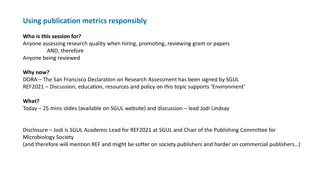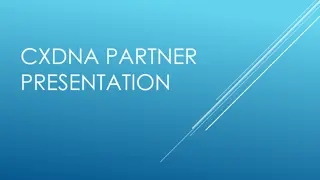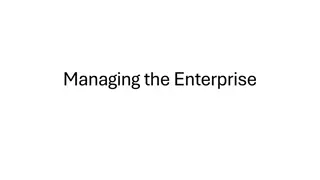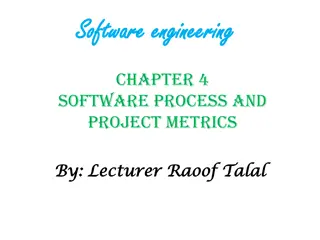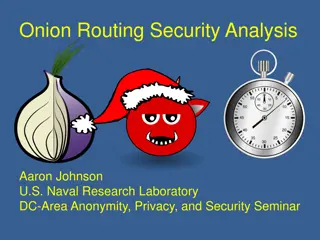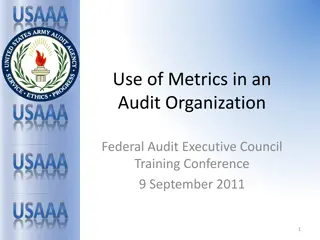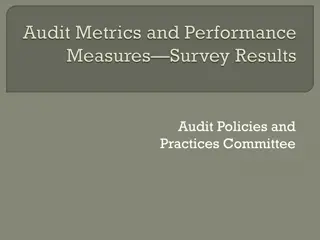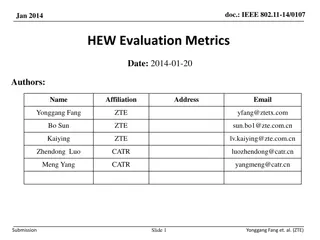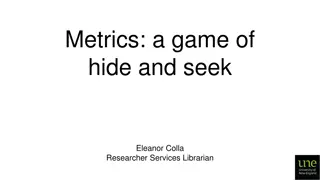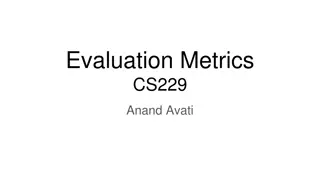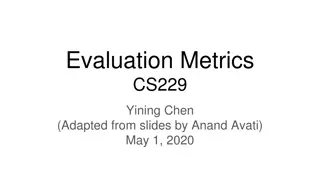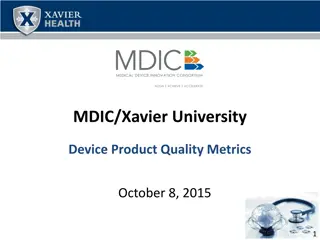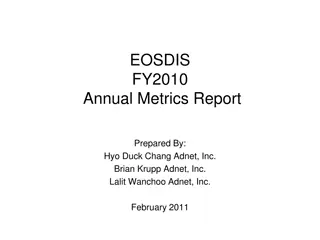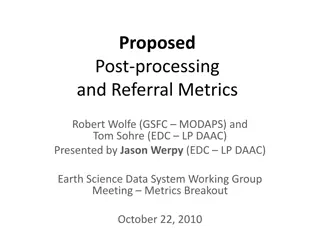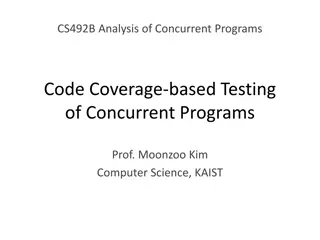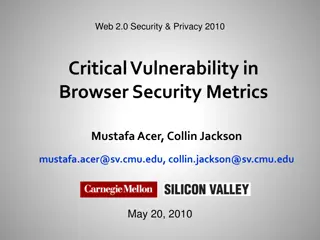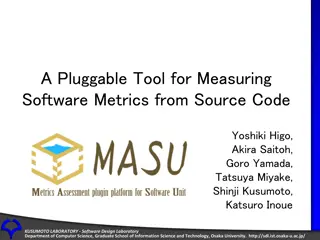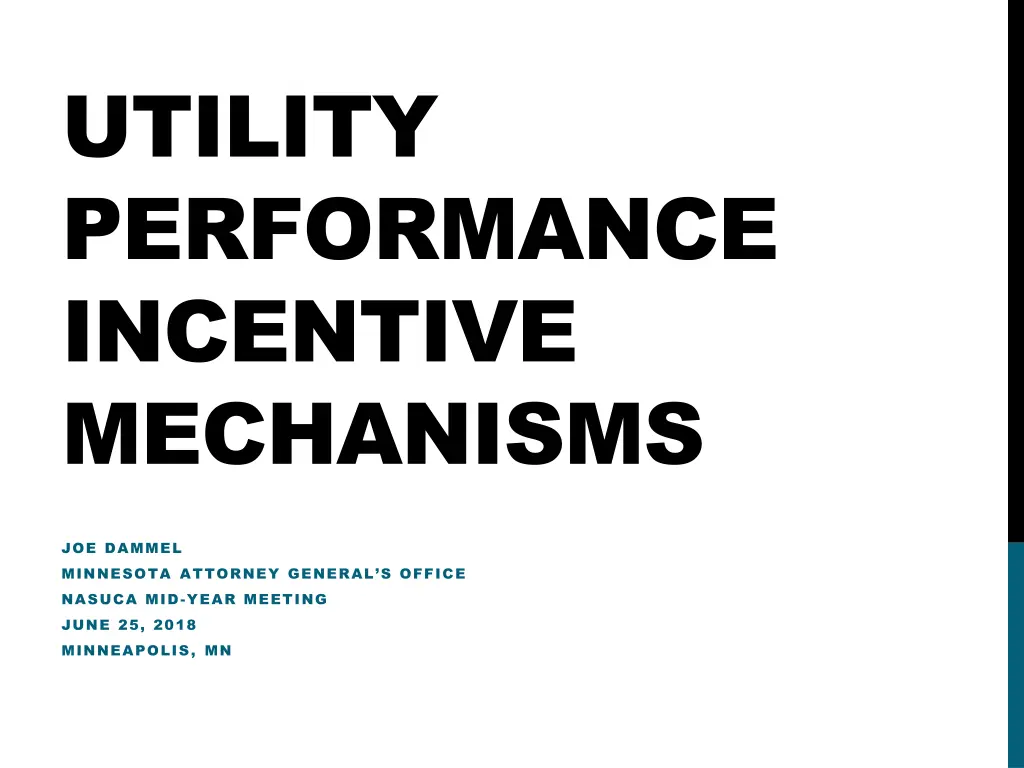
Building Effective Utility Performance Incentive Mechanisms
Explore the process of creating performance incentive mechanisms for utilities, starting from regulatory structures to achieving desired outcomes. Learn about key aspects such as demand, costs, throughput, efficiency, renewables, and more for enhancing the utility industry.
Download Presentation

Please find below an Image/Link to download the presentation.
The content on the website is provided AS IS for your information and personal use only. It may not be sold, licensed, or shared on other websites without obtaining consent from the author. If you encounter any issues during the download, it is possible that the publisher has removed the file from their server.
You are allowed to download the files provided on this website for personal or commercial use, subject to the condition that they are used lawfully. All files are the property of their respective owners.
The content on the website is provided AS IS for your information and personal use only. It may not be sold, licensed, or shared on other websites without obtaining consent from the author.
E N D
Presentation Transcript
UTILITY PERFORMANCE INCENTIVE MECHANISMS JOE DAMMEL MINNESOTA ATTORNEY GENERAL S OFFICE NASUCA MID-YEAR MEETING JUNE 25, 2018 MINNEAPOLIS, MN
If you wish to make an apple pie from scratch, you must first invent the universe. - C. Sagan
If you wish to make a performance incentive mechanism from scratch, you must first invent the existing cost-of-service utility regulatory structure. - Not C. Sagan
BUILDING THE SANDBOX
BUILDING THE SANDBOX DEMAND DEMAND COSTS COSTS
BUILDING THE SANDBOX THROUGHPUT THROUGHPUT CAPITAL CAPITAL
RENOVATING THE SANDBOX RATES RATES THROUGHPUT THROUGHPUT EFFICIENCY EFFICIENCY RENEWABLES RENEWABLES GHGs GHGs CAPITAL CAPITAL DERs DERs
RENOVATING THE SANDBOX ALT COST REC ALT COST REC THROUGHPUT THROUGHPUT MYRPs MYRPs FUEL ADJ. FUEL ADJ. DECOUPLING DECOUPLING CAPITAL CAPITAL INCENTIVES INCENTIVES
RETHINKING THE SANDBOX COMPONENTS OF A PIM: PERFORMANCE METRIC TARGET FINANCIAL INCENTIVE
RETHINKING THE SANDBOX 1. ARTICLUATE GOALS 2. ID DESIRED OUTCOMES 7. EVALUATE & REPEAT 6. EST. INCENTIVES 3. ID METRICS 5. EST. TARGETS 4. EST. METRICS
RETHINKING THE SANDBOX 1. ARTICLUATE GOALS 2. ID DESIRED OUTCOMES 7. EVALUATE & REPEAT 6. EST. INCENTIVES 3. ID METRICS 5. EST. TARGETS 4. EST. METRICS
GOALS OUTCOMES METRICS HIERARCHY GOALS OUTCOMES METRICS
GOALS OUTCOMES METRICS HIERARCHY GOALS WHY WE REGULATE OUTCOMES WHAT WE WANT METRICS WAYS TO MEASURE
GOALS OUTCOMES METRICS HIERARCHY Goals Goals Goals Goals Outcome Outcome Outcome Outcome Outcome Outcome Outcome Outcome Metric Metric Metric Metric Metric Metric Metric Metric Metric Metric Metric Metric Metric Metric Metric Metric
REGULATORY GOALS Why we regulate utilities. It is hereby declared to be in the public interest that public utilities be regulated as hereinafter provided in order to provide the retail consumers of natural gas and electric service in this state with adequate and reliable services at reasonable rates, consistent with the financial and economic requirements of public utilities and their need to construct facilities to provide such services or to otherwise obtain energy supplies, to avoid unnecessary duplication of facilities which increase the cost of service to the consumer and to minimize disputes between public utilities which may result in inconvenience or diminish efficiency in service to the consumers. Minn. Stat. s216B.01, Legislative Findings
REGULATORY GOALS Why we regulate utilities. It is hereby declared to be in the public interest that public utilities be regulated as hereinafter provided in order to provide the retail consumers of natural gas and electric service in this state with adequate and reliable services at reasonable rates, consistent with the financial and economic requirements of public utilities and their need to construct facilities to provide such services or to otherwise obtain energy supplies, to avoid unnecessary duplication of facilities which increase the cost of service to the consumer and to minimize disputes between public utilities which may result in inconvenience or diminish efficiency in service to the consumers. Minn. Stat. s216B.01, Legislative Findings
REGULATORY GOALS Why we regulate utilities. Customer Focus adequate and reliable services at reasonable rates Operational Effectiveness to avoid unnecessary duplication of facilities which increases the cost of service to the consumer Financial Performance consistent with the financial and economic requirements of public utilities Public Policy Responsiveness
REGULATORY GOALS Why do we regulate utilities? Operational Effectiveness Financial Performance Public Policy Responsiveness Customer Focus Outcome Outcome Outcome Outcome Outcome Outcome Outcome Outcome Metric Metric Metric Metric Metric Metric Metric Metric Metric Metric Metric Metric Metric Metric Metric Metric
DESIRED OUTCOMES What do we want from utilities? Operational Effectiveness Financial Performance Public Policy Responsiveness Customer Focus Outcome Outcome Outcome Outcome Outcome Outcome Outcome Outcome Metric Metric Metric Metric Metric Metric Metric Metric Metric Metric Metric Metric Metric Metric Metric Metric
DESIRED OUTCOMES: CUSTOMER FOCUS Customer What do we want from utilities? Focus Outcome Outcome Metric Metric Metric Metric
DESIRED OUTCOMES: CUSTOMER FOCUS What do we want from utilities? Customer Focus Service Quality Reliability Metric Metric Metric Metric
PERFORMANCE METRICS How do we measure? A metric should be: Tied to policy goals, outcomes Quantifiable Verifiable Clearly Defined Under Utility Control
PERFORMANCE METRICS How do we measure? Reliability is an outcome, SAIDI is a metric. Customer service is an outcome, call answer time is a metric. DER penetration is an outcome, interconnection wait time is a metric.
PERFORMANCE METRICS How do we measure? Customer Focus Service Quality Reliability Call answer time SAIDI # SAIFI Complaints
A POTENTIAL HIERARCHY Operational Effectiveness Financial Performance Customer Focus Public Policy Return-on- Equity Service Quality Cost Control Grid Mod. Customer Satisfaction Asset Mgmt. DERs Rider Revenue Carbon Intensity Affordability Resiliency Productivity Empowered Customers Energy Eff.
THREE PATHS PIMs Traditional Modern Hybrid
THANK YOU Follow along at home! MNPUC docket no. 17-401 Questions? Contact Joe Dammel, joseph.dammel@ag.state.mn.us


